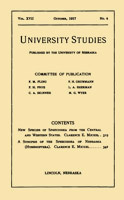University Studies of the University of Nebraska
Date of this Version
9-1953
Citation
University of Nebraska Studies, September 1955. NEW SERIES NO. 11.
Abstract
If this were spoken from a pulpit instead of from a teacher's rostrum, I should be disposed to take as a text for what follows a passage from C. W. Alvord's study of The Mississippi Valley in British Politics. From the middle of the 18th century to the Revolution, how to deal with the great valley was, Alvord holds, the number one American problem of every British ministry: How to meet the claims of France to it and how to defend it once her claims were extinguished; how to meet the claims to it of the seaboard colonies by virtue of their charters; how to protect the Indian title to the soil and against the "frauds and abuses" of traders and settlers; and finally, how best to make it of the greatest advantage to the English economy. The conflicting claims of France and England to the territory were discussed at the close of King George's War, 1744-1748, but neither side was prepared for a showdown and they were left unsettled by the treaty of Aix-la-Chappelle. A "cold war" ensued, each party seeking to strengthen its claim to the valley by occupation in one form or another, especially at the strategic Forks of the Ohio. The English got there "firstest," but the French, counting guns, got there with the "mostest," and the Virginians were driven back to the Atlantic side of the mountains. The "cold war" lasted seven years. Then followed seven years of bloody war, 1765-1763. We call it the French and Indian War, but it became a worldwide war. In the end France lost heavily in the Far East, in the West Indies, and on the North American continent. She surrendered Canada with its eighty or ninety thousand French population and her claims to the great region west of the Appalachians as far as the Mississippi River, except a small area at the mouth of the river held by Spain. How these vast acquisitions were to be managed was a problem full of difficulties. Very soon, however, it was decided to mark off East Florida and West Florida for the establishment of separate colonies, and the same was done for Canada though more than ten years passed before a colonial government was set up there. The great interior region west of the mountains, inhabited, save for a few French settlers in the Illinois country, only by scattered Indian tribes, was for the time being left an Imperial domain, without any commitment as to future colonial status. These decisions were announced in the Royal Proclamation on North America, October 7, 1763. Recognizing the Indian title to the soil, it declared all lands not hitherto purchased or ceded to the King a reservation for the use of the Indians until so acquired. It forbade the Colonial governors to "presume to make grants" of such lands or to purchase them until the King's pleasure should be known. All private persons were, likewise, forbidden to make purchases of them or to occupy them except on special license first obtained; and if any had "willfully or inadvertently" seated themselves on lands the title to which had not been acquired by the Crown, they were enjoined "forthwith to remove themselves from such settlements." The Indian trade, hitherto free, was also brought under imperial regulation. All traders were required to secure license from the colonial governor and give security to observe the regulations prescribed in them. By adopting a benevolent attitude toward the Indians, by placing the traders under strict regulation, by impliedly fixing western boundaries of the colonies at the mountains, by placing a sharp restriction upon westward expansion, the Proclamation reversed former British policy and ran counter to long-established colonial practices.
Included in
Economic History Commons, European History Commons, Political History Commons, Social History Commons, United States History Commons


Comments
Copyright (c) 1953 University of Nebraska